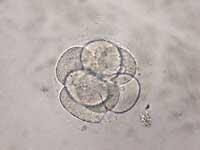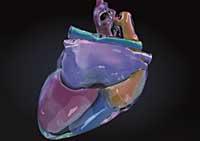Embryonic cell can be studied in Spain with stem cells
Farmazian doktorea. Biofarmazia, Farmakozinetika eta Farmazia-teknologiako irakasle kolaboratzailea
Farmazia Fakultatea UPV-EHU, Vitoria-Gasteiz

Many scientists have fought in Spain to investigate embryonic cells with mothers, and in the end it will be possible for a change of government. After hundreds of scandals, meetings and protests, it can be said that we are in a calm after the storm. In fact, since October it can be investigated in Spain with embryo stem cells. Thanks to the new law, this field of science, which until now has been banned, can be developed and received public grants.
Some projects are already underway. Before legalizing the research, Andalusia and Catalonia expressed their intention to investigate with embryonic stem cells, and the Minister of Health has announced that in Catalonia they will be dedicated to the medicine of textile engineering with embryonic stem cells, while in Andalusia a national cellular bank will be created.
Together with them, the University of Navarra has launched a research centre. The 350 researchers who will work there will speak with adult stem cells, not embryonic cells. In the CAPV, for its part, several projects are being prepared to work with stem cells, and a significant percentage of the upcoming budgets of the Basque Government can be for this area of science. In addition, it is planned to bring the famous researcher Juan Carlos Ispizua to a local scientific center. If this happened, we would have a scientist with incredible experience in the world of stem cells among us, which would be a great advantage for all research groups in the area.
The hope of medicine

Stem cell research had a major turning point in 1998. In fact, a group from the University of Wisconsin (USA) managed to grow human embryonic stem cells. Since then, thousands of scientific articles have been published and hundreds of companies have been created to develop the therapeutic potential of cells, and XXI stem cells. They have become therapeutic expectations of the twentieth century.
According to scientists, stem cells can have countless therapeutic applications: central nervous system diseases, Alzheimer's, Parkinson's, diabetes, heart disorders or blindness, or raw material for the production of tissue for transplants. But the limits remain as great as hope.
Many experts, for example, are not convinced that the culture media used for stem cell growth are totally safe or exposed to infections.

On the other hand, as is the case today with organ transplants, there is a risk that there will be an immune rejection in case of non-own stem cells. And cancer. Many research is being done to show that these cells are not exposed to cancer. The infinite fragmentation capacity of stem cells is essential for obtaining millions of cells and tissues. But, in turn, this ability must be strictly controlled, as animal studies have clearly shown that the risk of cancer is very high.
It is clear that much remains to be investigated and the decision adopted by the Spanish government has given a new vision and a future to stem cell technology.
A new one of these characteristics always has advantages and disadvantages, but in general we must think that the decision will allow us to work in the coming years a leading technology. And that working with embryonic cells will allow us to seek an answer to all these concerns.





